First Aid for Radiation Exposure: 6 Expert Tips
Radiation. The word conjures up images of glowing danger zones. But radiation is all around us, from sunshine to medical X-rays.
While high levels of radiation can be harmful, understanding what it is and how to react in case of exposure can help you stay calm and take the right steps.
This blog will guide you through the basics of first aid for radiation exposure. We’ll break down the different types, the signs to watch for, and what to do if you think you’ve been exposed.
Types of Radiation Exposure
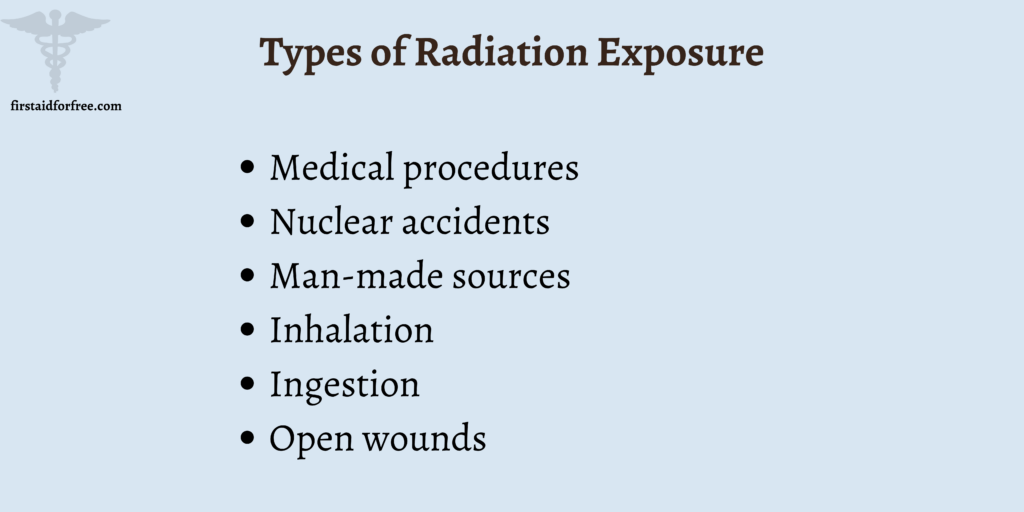
Radiation exposure can occur in two main ways: externally and internally.
External exposure happens when you’re near a radioactive source outside your body. This could be from:
- Medical procedures: X-rays, CT scans, and some types of cancer treatment radiation.
- Nuclear accidents: In rare cases, accidents at nuclear power plants or research facilities can release radioactive material into the environment.
- Man-made sources: Certain industrial processes or items like smoke detectors contain small amounts of radioactive materials that can cause external exposure if you’re in very close proximity for extended periods (highly unlikely in everyday situations).
Internal exposure occurs when radioactive materials get inside your body. This can happen through:
- Inhalation: Breathing in dust or particles containing radioactive material.
- Ingestion: Eating or drinking contaminated food or water.
- Open wounds: Radioactive material coming into direct contact with an open cut or sore.
The type and severity of your exposure will determine the first aid steps you need to take.
Signs and Symptoms of Radiation Sickness
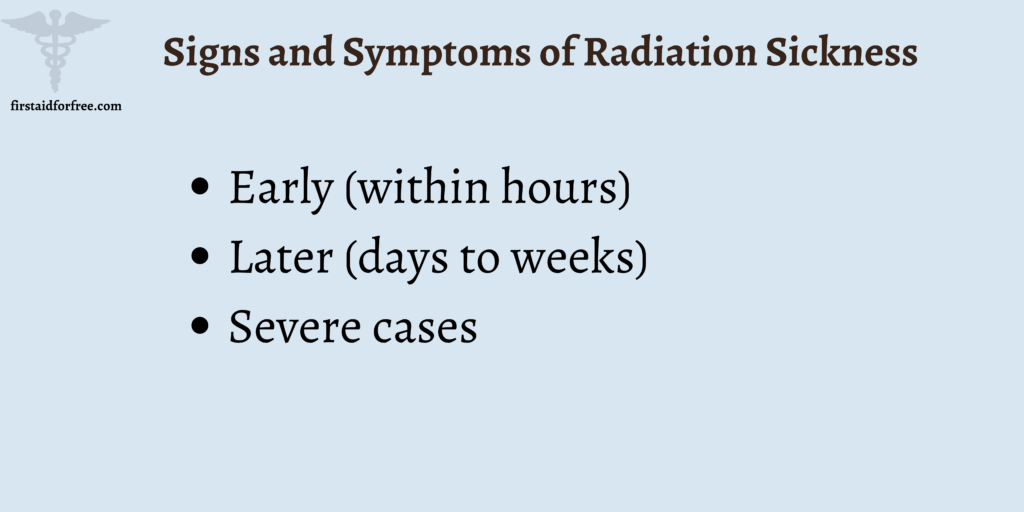
Radiation sickness, also known as Acute Radiation Syndrome (ARS), occurs when someone is exposed to a high dose of radiation in a short period.
- Early (within hours): Nausea, vomiting, diarrhea, headache, fatigue, and dizziness. These can be mistaken for the flu, but the timing after exposure is crucial.
- Later (days to weeks): Hair loss, skin burns (redness, peeling), loss of appetite, mouth sores, bleeding (nose, gums, etc.), and increased risk of infections due to a weakened immune system.
- Severe cases: In extreme situations, high doses can lead to confusion, disorientation, seizures, and even death.
It’s important to remember that these are just some of the potential symptoms. The severity and timing of their appearance can vary greatly depending on the individual and the type of exposure.
Even if you experience mild symptoms, especially after a known exposure, it’s crucial to seek medical attention to assess the situation and receive proper care.
First Aid for External Radiation Exposure
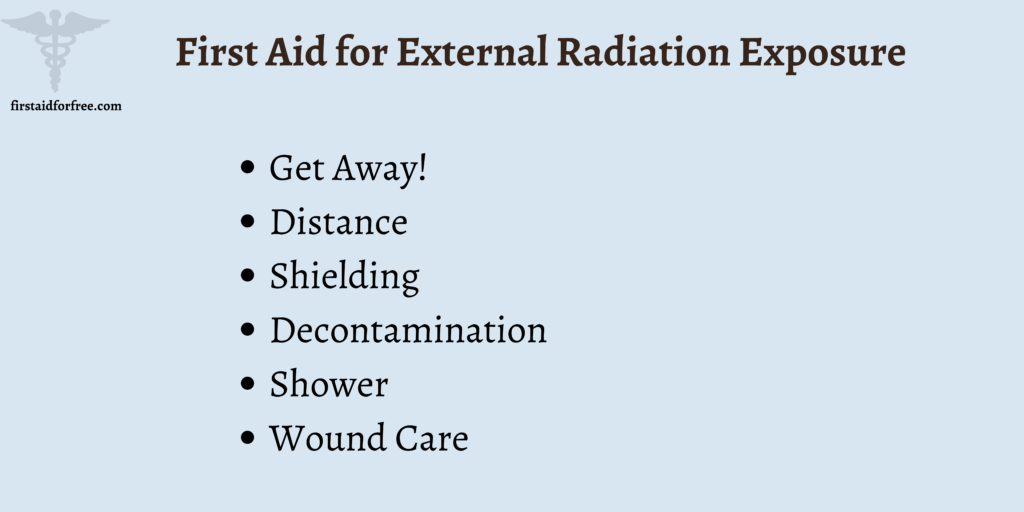
While radiation exposure can be a scary situation, remember the golden rule: Minimize further exposure. This is how you must handle external radiation exposure with first aid:
- Get Away! This might seem obvious, but time is critical. The longer you’re near the source, the higher the dose you receive. Move away from the source of radiation as quickly and safely as possible. If it’s safe to do so, help others evacuate as well.
- Distance: Radiation intensity weakens with distance. Even a few meters can significantly reduce your exposure. Don’t waste time searching for elaborate protection; getting some distance is the quickest way to minimize the dose.
- Shielding: If you can’t evacuate immediately and need to take temporary shelter, look for anything that can act as a shield between you and the radiation source. Concrete walls, buildings, or even large objects like machinery can offer some protection.
- Decontamination: Once you’re out of the immediate danger zone, it’s time to remove any contaminated clothing. Carefully remove outer garments and place them in a plastic bag or sealed container away from others. Wear gloves if available to avoid spreading contamination.
- Shower: Shower with lukewarm water and plenty of soap to remove any radioactive particles on your skin and hair. Don’t scrub, as this can break your skin and increase the risk of internal contamination. Wash your entire body, paying close attention to your hair and scalp.
- Wound Care: If you have any open wounds during exposure, prioritize cleaning them with clean water and a mild antiseptic solution. Cover the wounds with sterile dressings and seek medical attention as soon as possible.
First aid is meant to minimize further exposure and prevent the spread of contamination. Even if you feel okay after taking these steps, seeking medical attention is crucial to assess the extent of exposure and receive proper treatment.
Internal Radiation Exposure
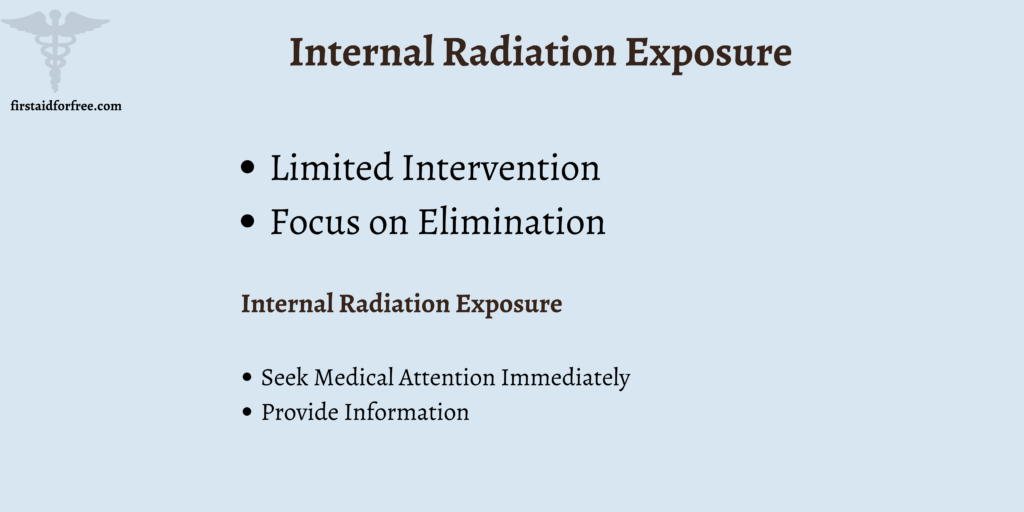
Internal radiation exposure occurs when radioactive materials enter your body. Unfortunately, there’s not much you can do in terms of first aid once it happens. Here’s why prevention is essential:
- Limited Intervention: Unlike external exposure, where you can remove yourself from the source, internal exposure involves radioactive material already inside your body. There’s no way to physically remove it with first aid.
- Focus on Elimination: The body naturally tries to eliminate ingested or inhaled radioactive materials through urine and feces. While first aid can’t directly remove the material, we can support the body’s natural elimination processes.
What you CAN do:
- Seek Medical Attention Immediately: If you suspect internal radiation exposure (e.g., inhaled dust in a contaminated area or ingested contaminated food), get to a hospital or emergency room as soon as possible. Early intervention can be crucial in some cases.
- Provide Information: Tell medical professionals about the suspected source and type of radioactive material you might have been exposed to. This helps them determine the best course of treatment.
Internal radiation exposure is a serious situation, and first aid can’t replace professional medical intervention.
Tips for Managing Anxiety After Exposure
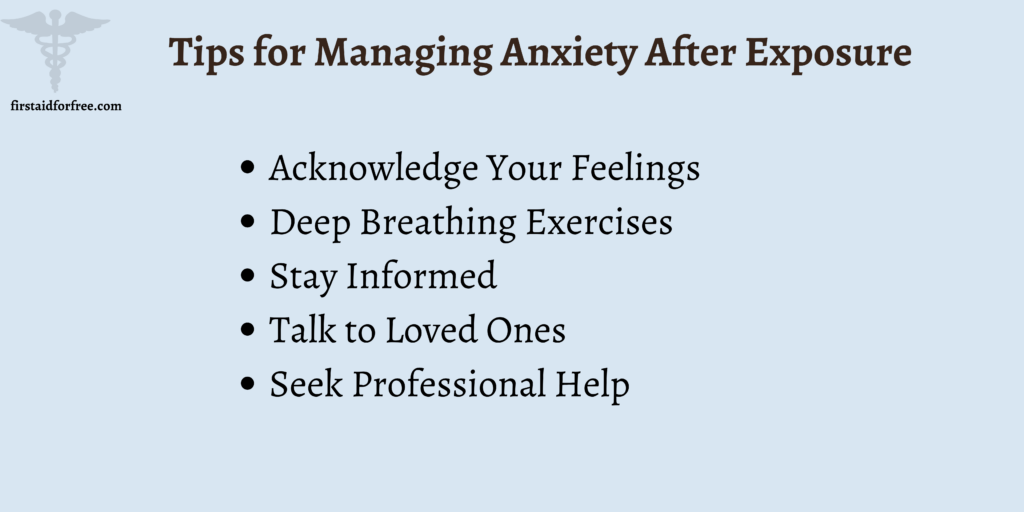
Radiation exposure, even suspected exposure, can be a nerve-wracking experience. Some tips to help manage that anxiety:
- Acknowledge Your Feelings: It’s perfectly normal to feel scared or anxious after exposure. Don’t bottle it up.
- Deep Breathing Exercises: Taking slow, deep breaths can calm your nervous system and help you focus. Find a quiet place and practice deep breathing techniques for a few minutes.
- Stay Informed: Seek reliable information from reputable sources, such as government health websites or organizations like the World Health Organization (WHO). Understanding the risks and potential health effects can ease some anxieties.
- Talk to Loved Ones: Talking to friends and family about your experience can be a great way to release your worries and gain support.
- Seek Professional Help: If anxiety is interfering with your daily life, consider reaching out to a therapist or counselor for additional support and coping mechanisms.
FAQs
What should I do if I think I’ve been exposed to radiation?
Get away from the source as quickly as possible. If you have radioactive material on your clothes, remove them carefully and shower with lukewarm water. Seek medical attention immediately, even if you feel okay.
Can I get radiation sickness from a medical X-ray?
X-rays use very low doses of radiation. The benefits of medical imaging usually outweigh the minimal risks involved.
How can I prevent internal radiation exposure?
Avoid contaminated food and water sources. If you work in an environment with potential radiation risks, follow all safety protocols and wear appropriate protective gear.
Conclusion
Radiation exposure can be a scary situation, but with the right knowledge, you can take control. Remember, the key points are to minimize further exposure, follow basic first aid steps, and seek medical attention as soon as possible.
Stay calm and take the right actions to navigate a stressful situation with confidence.





